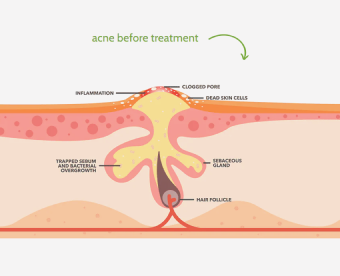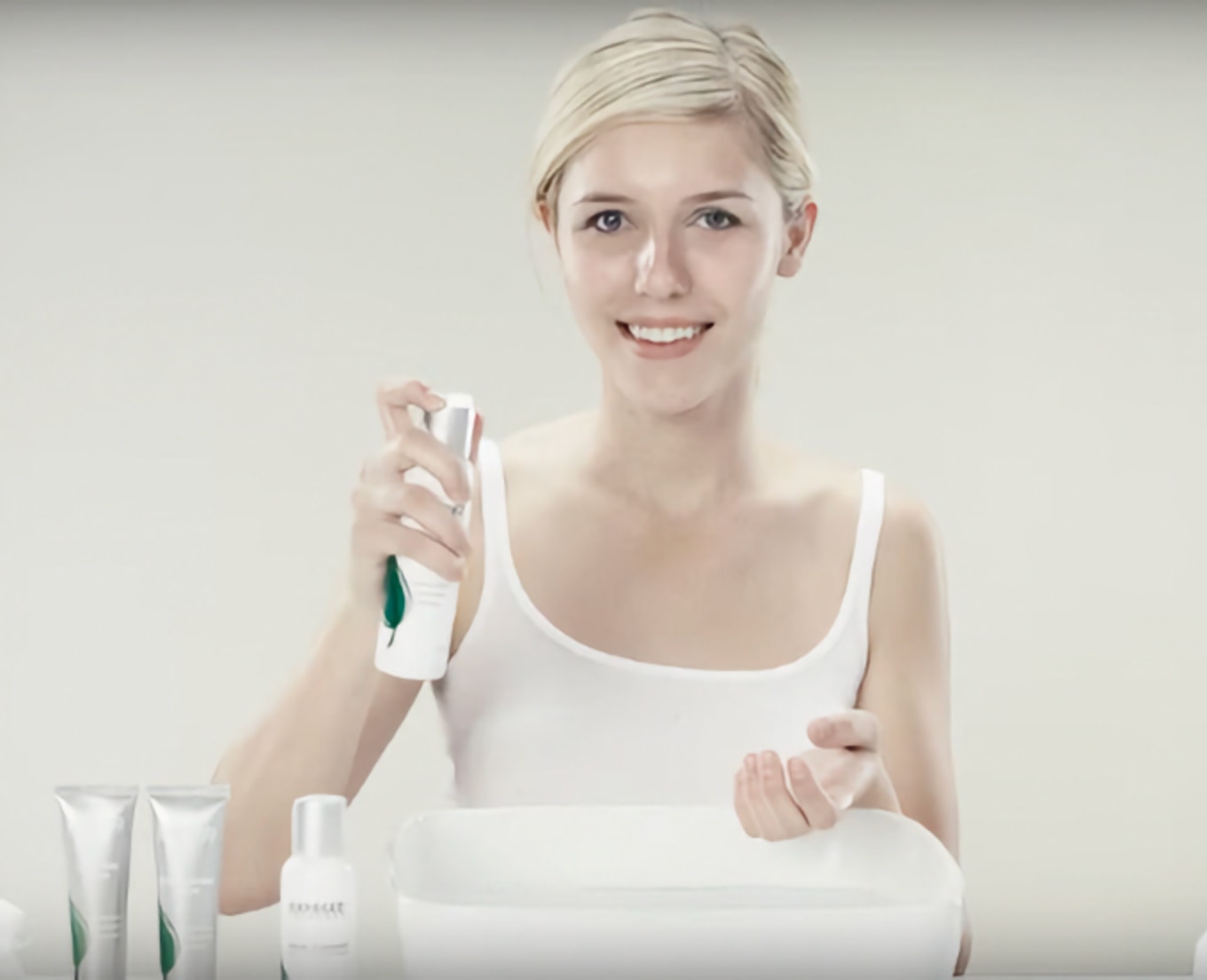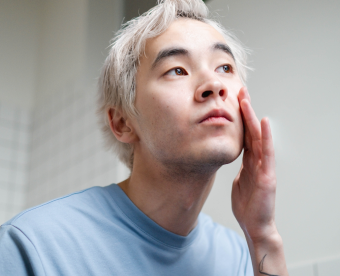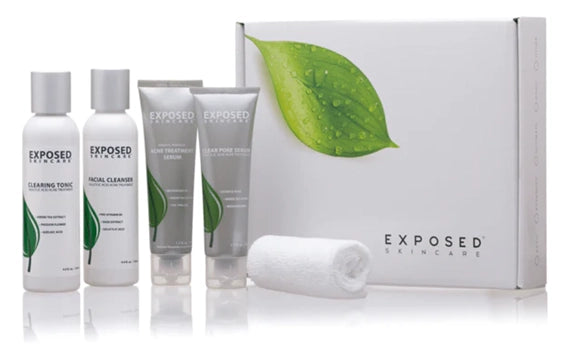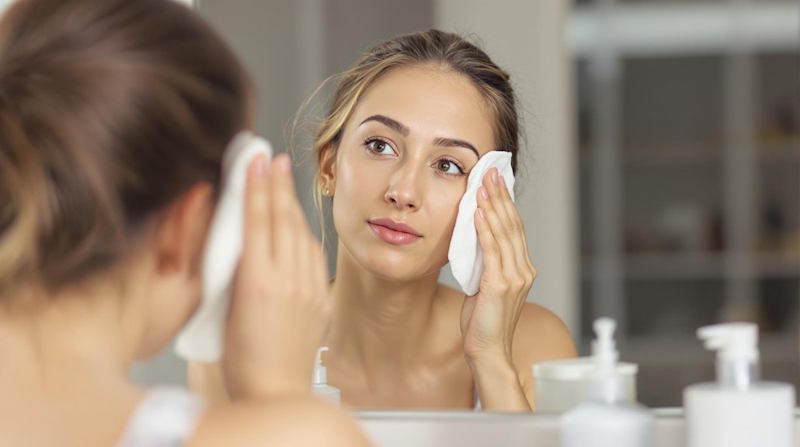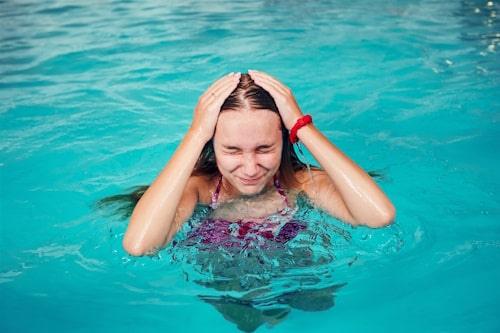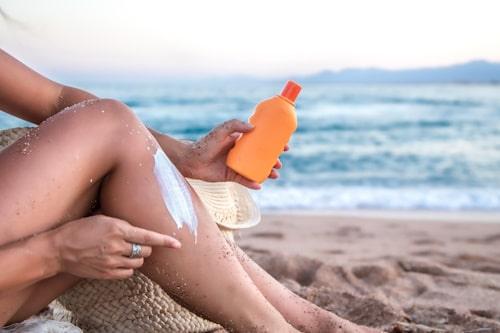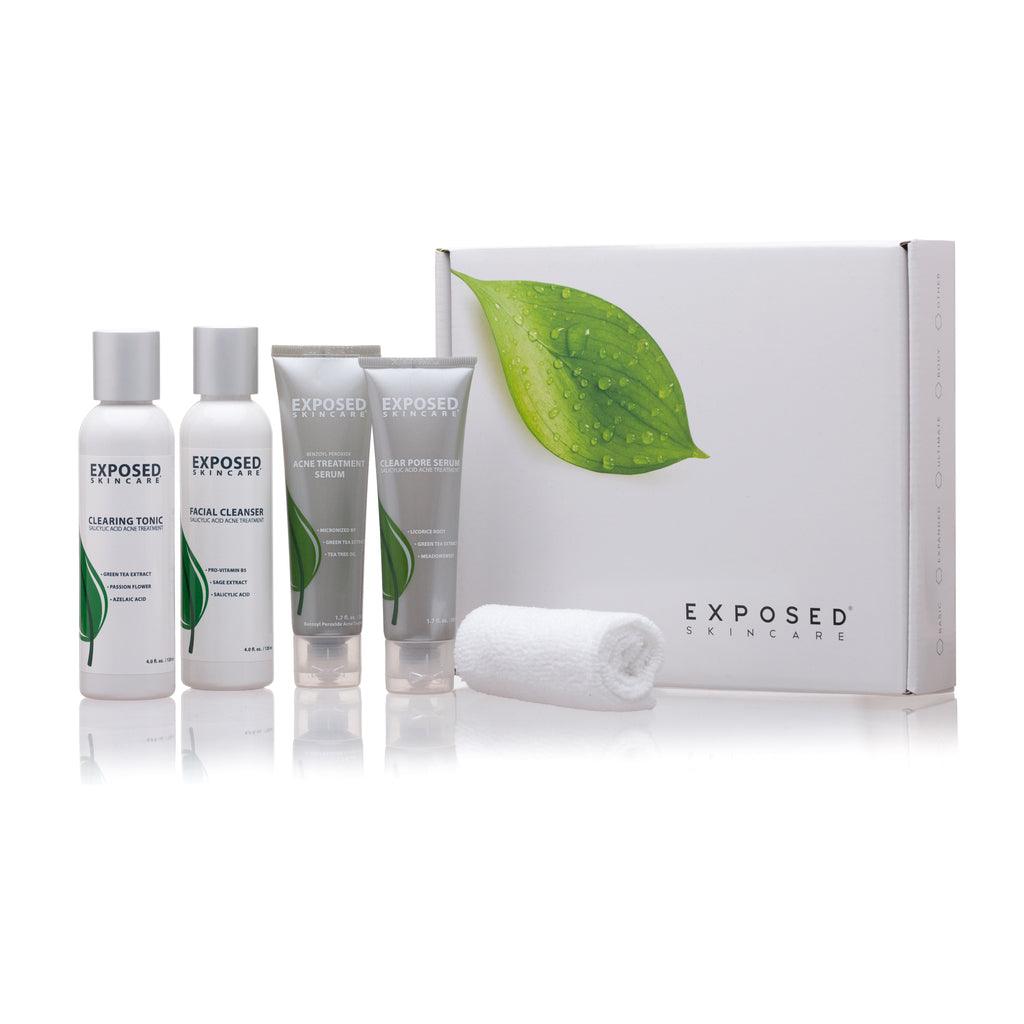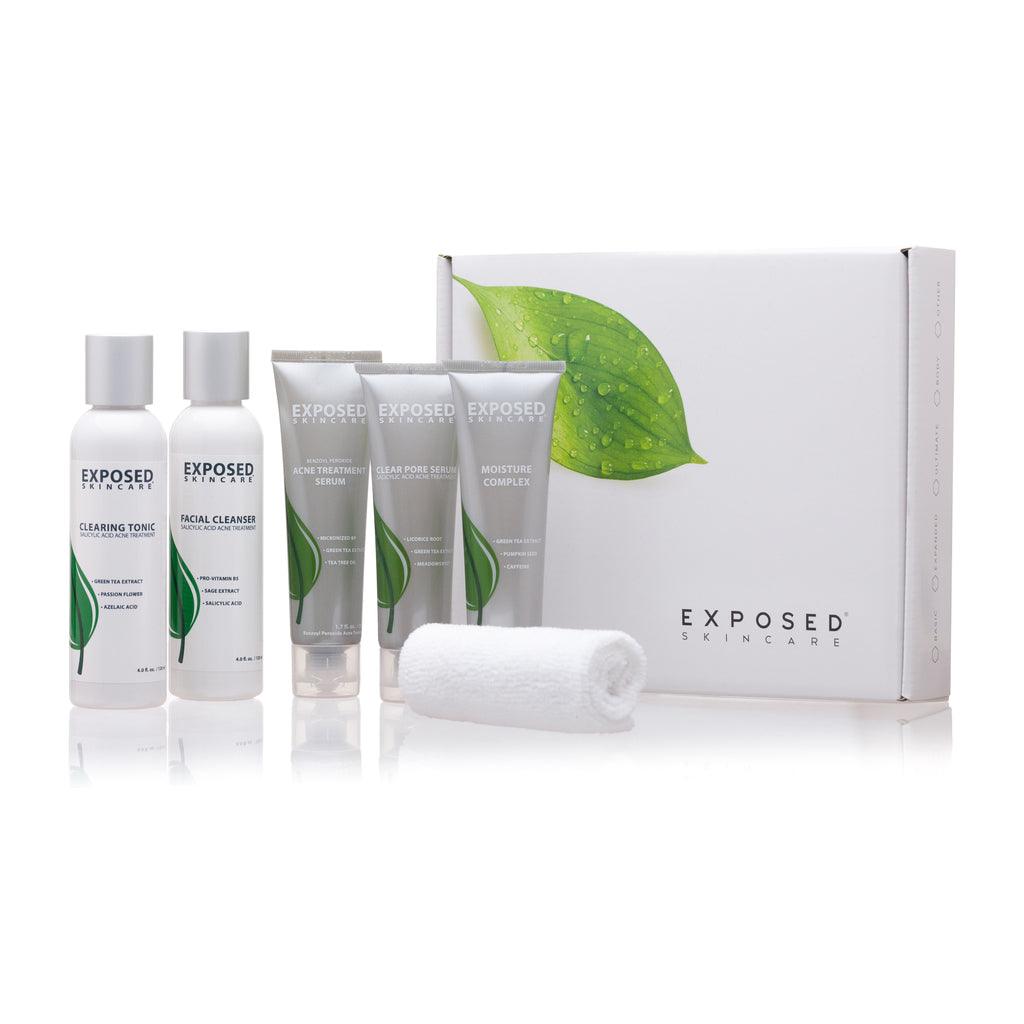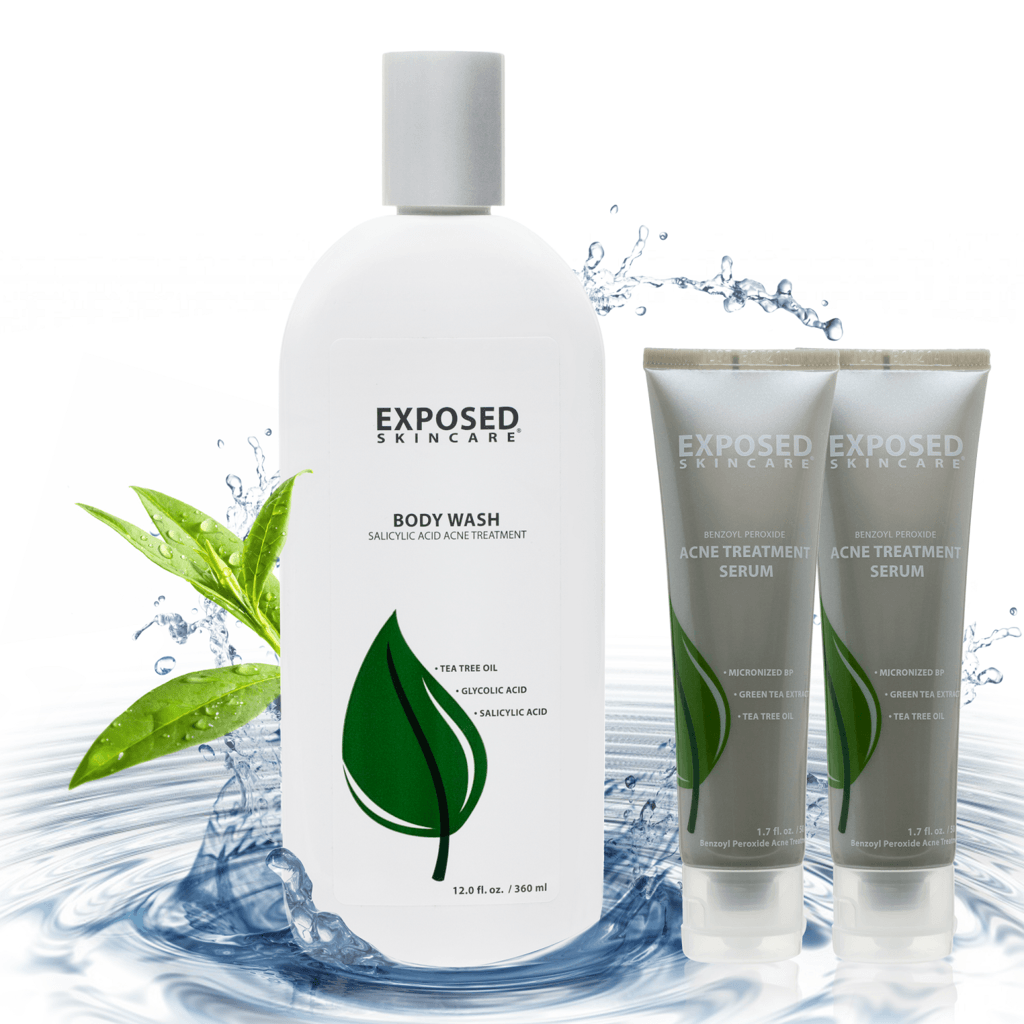Does minoxidil cause acne? This question has garnered significant attention among individuals battling hair loss. Minoxidil, known for stimulating new hair growth, has been a staple in the hair loss treatment market.
But as with any medication, it comes with side effects, some more common than others. This guide will investigate whether minoxidil can lead to acne and how to prevent acne.
Also read: How to choose the best acne treatment
Biggest Take-Aways;
- Minoxidil is effective for hair loss but can cause side effects like skin irritation and acne.
- Various forms of minoxidil are available, including topical solutions and foam, each with its own set of potential side effects.
- Using minoxidil in combination with other hair loss treatments like finasteride may offer better results but could increase the risk of side effects.
- Exposed Skin Care can help manage skin-related side effects of minoxidil, offering a more holistic approach to skin and hair health.

The Basics of Minoxidil: What It Is and How It Works
Minoxidil is an over-the-counter medication primarily used to treat hair loss and stimulate hair regrowth. It is often available in topical solutions and foam and is applied directly to the scalp.
But before we explore the main topic—does minoxidil cause acne—it is essential to understand how this medication works on your hair and scalp.
The Action Mechanism
Minoxidil works by prolonging the growth phase of hair follicles. It widens blood vessels, allowing more oxygen, blood, and nutrients to reach the hair follicle, encouraging hair to grow thicker and longer.
Forms of Minoxidil
- Topical Minoxidil: Usually in liquid or foam, applied directly to the scalp.
- Oral Minoxidil: Less commonly used but available for more severe hair loss cases.
Does Minoxidil Cause Acne: The Scientific Insight
"Does minoxidil cause acne?" has a nuanced answer. While minoxidil is designed to stop hair loss and promote new hair growth, its application can lead to several side effects, including skin irritation and acne.
The Connection to Acne
Minoxidil has ingredients that may cause the skin to react, particularly sensitive skin. The topical application of minoxidil solution or foam can result in skin irritation, which may also cause acne breakouts.

Common Side Effects of Minoxidil
Some common side effects of minoxidil include:
- Itching
- Skin irritation
- Dryness
- Redness
- Flakiness
Less Common Side Effects
Minoxidil can cause side effects that are less common but still noteworthy:
- Unwanted facial hair growth
- Headache
- Dizziness
Finasteride and Minoxidil: A Double-Edged Sword?
Finasteride and minoxidil are often used together for better results in treating hair loss. While finasteride is primarily in pill form and inhibits the hormone responsible for hair thinning, minoxidil is a topical application to stimulate hair growth.
When Used Together
The effects can be increased when you take finasteride and apply minoxidil simultaneously. However, using both products can also cause more chances of side effects, including acne.
Separate Use vs. Combined Use
- Separate Use: When used separately, each product has its own set of side effects.
- Combined Use: When used together, you may experience side effects from minoxidil and finasteride, such as dryness and skin irritation, which may be causing acne.
Can Minoxidil Cause Adverse Effects Other Than Acne?
While our main concern is whether minoxidil causes acne, other adverse effects are worth exploring.
Other Skin Conditions
- Minoxidil can cause skin irritation: Dry, flaky skin is often a complaint.
- Facial Hair Growth: Especially in women, topical minoxidil can cause unwanted facial hair.

Non-Skin Related Side Effects
- Dizziness and Headaches: Less commonly reported but still possible.
- Heart Palpitations: Very rare but crucial to be aware of.
Best Practices When Using Minoxidil
Despite the side effects, many still find minoxidil an effective treatment for hair loss. Here are some ways to get the best results while minimizing side effects.
Apply Minoxidil Properly
- Avoid Overapplication: Stick to the recommended dosage.
- Use a Pipette or Spray: For even application.
Keep Your Skin Clean
- Use Non-Irritating Cleansers: To remove dead skin cells and prevent pore-clogging.
- Avoid Harsh Scrubbing: This can exacerbate irritation.

Be Mindful of Clothing
Minoxidil can stain clothing, so it's essential to let it dry before dressing.
Minoxidil and Acne: Is There a Verifiable Link?
Does minoxidil cause acne? The answer isn’t black and white. While minoxidil is primarily used to stimulate hair growth and has helped countless people keep the hair they have, it can cause side effects like skin irritation, which can lead to acne.
Individual Responses Vary
Each person’s skin reacts differently to minoxidil. While some may experience acne, others might suffer from dryness or redness instead.
External Factors
External factors like the use of other topical creams, dietary habits, and existing medications can also influence whether minoxidil will cause acne.
Keep an Eye on Symptoms
Notice acne breakouts after starting minoxidil? It may be related, but other causes of acne should not be ruled out either.
Managing Acne with Exposed Skin Care While Using Minoxidil
If you're grappling with acne while taking minoxidil for hair loss, a holistic skincare regimen like Exposed Skin Care is worth considering. Minoxidil's side effects can often include skin irritations that lead to acne.
Here are some reasons to choose Exposed Skin Care:
- Counteracts Side Effects: Minoxidil tends to cause issues like dryness and irritation. Exposed Skin Care helps in maintaining skin hydration and preventing flakiness.
- Healthy Hair and Skin: While minoxidil is one of the popular hair loss medications aimed at giving you back your healthy hair, Exposed Skin Care targets the overall health of your skin.
- Prevents Unwanted Breakouts: Using minoxidil solution or foam can sometimes lead to unwanted acne. Exposed Skin Care's Treatment Serum is formulated to effectively reduce and prevent acne blemishes.
- Safe to Use Together: Exposed Skin Care seamlessly fits into routines, including hair loss medications like minoxidil and finasteride.
Integrating Exposed Skin Care into your daily regimen can thus serve as a safety net, helping you tackle potential side effects from minoxidil while ensuring that your journey to healthier hair is back on track without any setbacks.
Conclusion
Navigating the complexities of hair loss treatments like minoxidil can be intricate. Despite its efficacy in treating hair loss, minoxidil doesn't come without its downsides. While some side effects of minoxidil products are usually mild, skin irritation, unwanted hair growth, and hair shedding have been reported.
It is essential to be vigilant about the product's potential to disturb your skin's equilibrium. The issue is even more critical for people using minoxidil off-label to treat hair conditions other than the medically approved uses.
The effects of topical minoxidil, whether oral or topical, extend beyond your scalp. This reality underscores the need for a holistic approach to skincare and hair care.
While minoxidil may cause certain adverse effects, using a trusted skincare line like Exposed Skin Care can help manage some of these skin-related side effects without compromising the treatment's effectiveness.
It is notable that minoxidil has also enabled countless individuals to regain their confidence through new hair growth. Still, it's important to approach your hair loss treatment as a comprehensive wellness strategy rather than just a single-target solution.
FAQs
Does minoxidil cause acne?
Yes, some users have reported acne as a side effect of using minoxidil, although it is not extremely common.
What are the common side effects of minoxidil?
Common side effects include scalp irritation, unwanted hair growth in areas other than the scalp, and sometimes hair shedding.
Can minoxidil be used in combination with other hair loss treatments like finasteride?
Yes, many people use minoxidil and finasteride together for more effective results. However, this may increase the risk of side effects.
What are the different forms of minoxidil available?
Minoxidil is available as a topical solution, a topical foam, and in oral forms. The most commonly used are the topical solution and foam.
Can minoxidil cause hair shedding?
Yes, minoxidil can initially cause hair shedding, which is usually temporary and part of the regrowth process.
How does Exposed Skin Care help if you're using minoxidil?
Thanks to its hydrating and acne-fighting ingredients, exposed Skin Care can help manage the skin-related side effects of minoxidil, like dryness and acne.
Can you apply minoxidil to wet hair?
Applying minoxidil to dry hair and scalp is recommended for the best results.
Is it possible to experience itching from minoxidil?
Yes, itching is a known side effect, especially when using the product.
Should you consult a hair specialist before using minoxidil?
While consulting a specialist is not mandatory, it is advisable if you have specific concerns or plan to use minoxidil off-label.
Can minoxidil foam stain clothing?
No, minoxidil foam is less likely to stain clothing compared to the topical solution.

